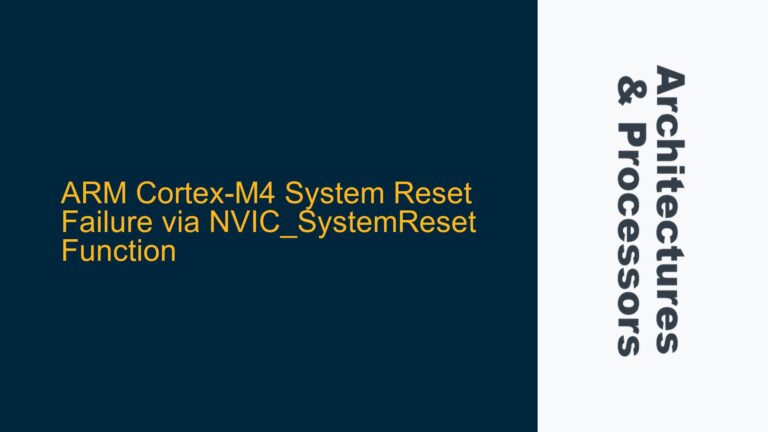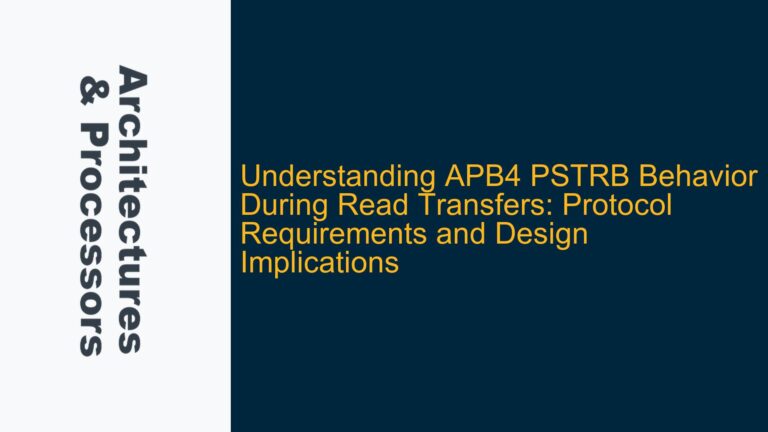Cortex-R52+ Interrupt Latency: Key Factors and Realistic Benchmarks
Interrupt latency is a critical performance metric in real-time embedded systems, particularly when using high-performance processors like the ARM Cortex-R52+. The Cortex-R52+ is designed for safety-critical applications, such as automotive and industrial systems, where deterministic and low-latency interrupt handling is paramount. Understanding the typical interrupt latency figures for the Cortex-R52+ requires a deep dive into its architecture, the factors influencing latency, and the interplay between hardware and software.
The Cortex-R52+ features a dual-core configuration with support for lockstep execution, which enhances fault tolerance but also introduces additional complexity in interrupt handling. The processor’s interrupt controller, memory subsystem, and pipeline architecture all contribute to the overall latency. While ARM provides general guidelines, the actual interrupt latency can vary significantly depending on the silicon vendor’s implementation, system configuration, and software optimizations.
In a typical Cortex-R52+ system, the interrupt latency can be broken down into several components: the time taken for the interrupt signal to propagate through the system, the time required for the processor to acknowledge the interrupt, the context switching overhead, and the time taken to execute the interrupt service routine (ISR). Each of these components can be influenced by factors such as cache state, memory access times, and the presence of higher-priority interrupts.
For example, if the Cortex-R52+ is executing a high-priority task with interrupts disabled, the latency for a lower-priority interrupt will increase. Similarly, if the processor’s caches are disabled or invalidated, the time required to fetch the ISR code and data from main memory will add to the overall latency. The Cortex-R52+ also supports nested interrupts, which can further complicate latency calculations by introducing additional context switching overhead.
To provide a realistic benchmark, the Cortex-R52+ typically exhibits an interrupt latency in the range of 10 to 50 cycles under optimal conditions. However, this figure can increase to several hundred cycles in less ideal scenarios, such as when dealing with cache misses or high system load. These figures are highly dependent on the specific implementation and should be validated through empirical testing on the target hardware.
Memory Subsystem and Pipeline Effects on Cortex-R52+ Interrupt Latency
The memory subsystem and pipeline architecture of the Cortex-R52+ play a significant role in determining interrupt latency. The Cortex-R52+ features a multi-stage pipeline with support for out-of-order execution, which can introduce variability in interrupt response times. When an interrupt occurs, the processor must complete or flush the current instruction pipeline before it can begin executing the ISR. This pipeline flush operation can add several cycles to the overall latency, particularly if the pipeline is deep and contains multiple instructions in various stages of execution.
The memory subsystem, including the L1 and L2 caches, also has a direct impact on interrupt latency. If the ISR code or data is not present in the cache, the processor must fetch it from main memory, which can take significantly longer than a cache hit. The Cortex-R52+ supports cache locking, which can be used to ensure that critical ISR code and data remain in the cache, reducing latency. However, this must be balanced against the need to maintain cache efficiency for other tasks.
Another factor to consider is the memory access time for the interrupt vector table. The Cortex-R52+ uses a vector table to store the addresses of ISRs, and the time required to access this table can contribute to the overall latency. If the vector table is located in slow memory or is not cached, the latency will increase. To mitigate this, the vector table should be placed in fast, tightly coupled memory (TCM) or locked in the cache.
The Cortex-R52+ also supports branch prediction, which can help reduce the latency of ISR execution by predicting the target address of the ISR and prefetching the necessary instructions. However, if the branch predictor mispredicts the ISR entry point, the processor must flush the pipeline and fetch the correct instructions, adding to the latency. Properly tuning the branch predictor and ensuring that the ISR entry points are well-defined can help minimize this effect.
Optimizing Cortex-R52+ Interrupt Handling for Minimal Latency
To achieve minimal interrupt latency on the Cortex-R52+, several optimization techniques can be employed. First, the ISR code and data should be placed in fast memory, such as TCM or locked in the L1 cache. This ensures that the processor can quickly access the necessary instructions and data without waiting for main memory. Additionally, the interrupt vector table should be located in fast memory to reduce the time required to fetch the ISR address.
Second, the use of nested interrupts should be carefully managed. While nested interrupts can improve system responsiveness, they also introduce additional context switching overhead, which can increase latency. In systems where deterministic latency is critical, it may be preferable to disable nested interrupts and prioritize ISRs based on their urgency.
Third, the Cortex-R52+ supports various power-saving modes, which can affect interrupt latency. When the processor is in a low-power state, it may take additional time to wake up and respond to an interrupt. To minimize latency, the processor should be kept in an active state during periods when low-latency interrupt handling is required.
Fourth, the Cortex-R52+ provides several hardware features that can be used to reduce interrupt latency, such as the Generic Interrupt Controller (GIC) and the Memory Protection Unit (MPU). The GIC allows for efficient prioritization and routing of interrupts, while the MPU can be used to protect critical ISR code and data from being evicted from the cache. Proper configuration of these features can help ensure that the processor responds to interrupts as quickly as possible.
Finally, empirical testing and profiling should be used to validate the interrupt latency on the target hardware. This involves measuring the time from the occurrence of an interrupt to the start of ISR execution under various conditions, such as different cache states and system loads. The results of these tests can be used to identify and address any bottlenecks in the interrupt handling process.
In conclusion, achieving minimal interrupt latency on the Cortex-R52+ requires a thorough understanding of the processor’s architecture and careful optimization of both hardware and software. By addressing the key factors that influence latency and employing the appropriate optimization techniques, it is possible to achieve deterministic and low-latency interrupt handling in even the most demanding real-time systems.






